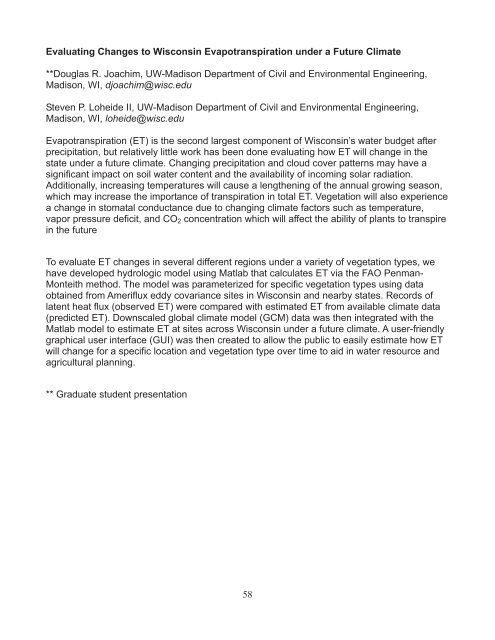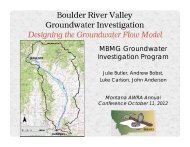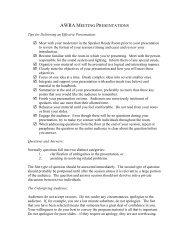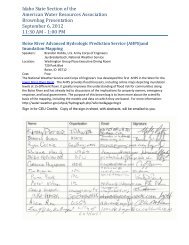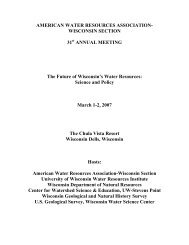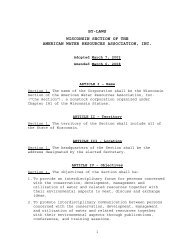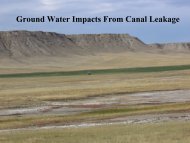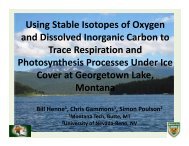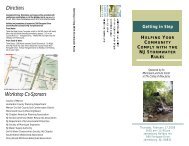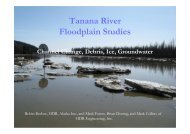Wisconsin's Role in Great Lakes Restoration - American Water ...
Wisconsin's Role in Great Lakes Restoration - American Water ...
Wisconsin's Role in Great Lakes Restoration - American Water ...
You also want an ePaper? Increase the reach of your titles
YUMPU automatically turns print PDFs into web optimized ePapers that Google loves.
Evaluat<strong>in</strong>g Changes to Wiscons<strong>in</strong> Evapotranspiration under a Future Climate<br />
**Douglas R. Joachim, UW-Madison Department of Civil and Environmental Eng<strong>in</strong>eer<strong>in</strong>g,<br />
Madison, WI, djoachim@wisc.edu<br />
Steven P. Loheide II, UW-Madison Department of Civil and Environmental Eng<strong>in</strong>eer<strong>in</strong>g,<br />
Madison, WI, loheide@wisc.edu<br />
Evapotranspiration (ET) is the second largest component of Wiscons<strong>in</strong>’s water budget after<br />
precipitation, but relatively little work has been done evaluat<strong>in</strong>g how ET will change <strong>in</strong> the<br />
state under a future climate. Chang<strong>in</strong>g precipitation and cloud cover patterns may have a<br />
significant impact on soil water content and the availability of <strong>in</strong>com<strong>in</strong>g solar radiation.<br />
Additionally, <strong>in</strong>creas<strong>in</strong>g temperatures will cause a lengthen<strong>in</strong>g of the annual grow<strong>in</strong>g season,<br />
which may <strong>in</strong>crease the importance of transpiration <strong>in</strong> total ET. Vegetation will also experience<br />
a change <strong>in</strong> stomatal conductance due to chang<strong>in</strong>g climate factors such as temperature,<br />
vapor pressure deficit, and CO2 concentration which will affect the ability of plants to transpire<br />
<strong>in</strong> the future<br />
To evaluate ET changes <strong>in</strong> several different regions under a variety of vegetation types, we<br />
have developed hydrologic model us<strong>in</strong>g Matlab that calculates ET via the FAO Penman-<br />
Monteith method. The model was parameterized for specific vegetation types us<strong>in</strong>g data<br />
obta<strong>in</strong>ed from Ameriflux eddy covariance sites <strong>in</strong> Wiscons<strong>in</strong> and nearby states. Records of<br />
latent heat flux (observed ET) were compared with estimated ET from available climate data<br />
(predicted ET). Downscaled global climate model (GCM) data was then <strong>in</strong>tegrated with the<br />
Matlab model to estimate ET at sites across Wiscons<strong>in</strong> under a future climate. A user-friendly<br />
graphical user <strong>in</strong>terface (GUI) was then created to allow the public to easily estimate how ET<br />
will change for a specific location and vegetation type over time to aid <strong>in</strong> water resource and<br />
agricultural plann<strong>in</strong>g.<br />
** Graduate student presentation<br />
58


